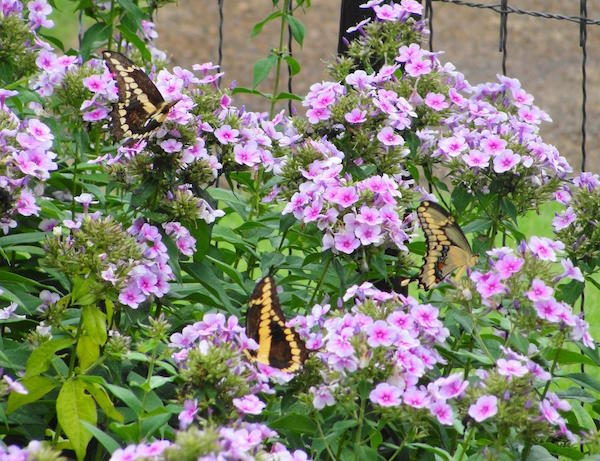
Giant swallowtail butterflies nectaring on Phlox paniculata ‘John Fanick’.
July 2, 2024 - East Texas is home to a wide array of fascinating wildlife, including the giant swallowtail butterfly. Known for its impressive size and striking appearance, this butterfly is a frequent visitor to our gardens.
The giant swallowtail butterfly is the largest butterfly in North America, with wingspans ranging from 4 to 6 inches. Its distinctive coloration makes it easy to identify: the upper wings are primarily black with yellow bands (some call it a big yellow “smile”) while the lower wings are mostly yellow with black outlines highlighted with a few blue and brick-red spots. Therefore, it looks completely different depending on whether the wings are open or closed.
Understanding the life cycle of the giant swallowtail can help gardeners create a supportive environment for this butterfly. The life cycle consists of four stages: egg, larva (caterpillar), pupa (chrysalis), and adult.
Egg: Female butterflies lay their tiny, spherical eggs on the leaves of host plants in the citrus family. In East Texas, the host plants include native Hercules club (toothache tree) and wafer ash (hop tree) along with cultivated citrus and rue.
Larva: Upon hatching, the larvae, known for their unique appearance, resemble bird droppings, a clever adaptation to avoid predators. As they mature, the caterpillars grow to about 2 inches long and develop distinctive patterns of white, brown, and green.
Pupa: The caterpillars then form a chrysalis, where they undergo metamorphosis. The chrysalis can be brown or green, blending in with its surroundings to avoid detection.
Adult: After about two weeks, the adult butterfly emerges, ready to continue the cycle. On average, adults live only one to two weeks.
Creating a butterfly-friendly garden involves providing both nectar sources for adults and host plants for larvae. Here are some tips to make your garden a haven for giant swallowtails:
Plant Host Plants: Incorporate host plants such as citrus and rue while preserving Hercules club and wafer ash on fence rows and in woodlands. These plants are essential for the butterfly’s reproductive cycle, as they provide the necessary foliage for caterpillars to feed on.
Provide Nectar Sources: Adult giant swallowtails feed on nectar from a variety of flowering plants including butterfly bush, lantana, phlox, vitex, and zinnias. These plants not only attract giant swallowtails but also support other pollinators.
Create a Water Source: Butterflies need water to stay hydrated. A shallow dish filled with water and pebbles can serve as a drinking spot. Be sure to keep the water fresh and clean.
Avoid Pesticides: Pesticides tend to be indiscriminate insect killers and can be harmful to butterflies in all stages of their life. Choose natural pest control methods to maintain a healthy garden ecosystem.
Provide Shelter: Butterflies need shelter from predators and harsh weather. An assortment of dense shrubs and perennials can offer the necessary protection.
The giant swallowtail butterfly is a dynamic insect that brings beauty and ecological benefits to our East Texas gardens. By understanding their life cycle and providing the right environment, we gardeners can help support the population of these showy butterflies. Whether you are a seasoned gardener or just starting, creating a butterfly-friendly garden is a rewarding way to connect with nature and contribute to the conservation of these captivating creatures.
Greg Grant is the Smith County horticulturist and Master Gardener coordinator for the Texas A&M AgriLife Extension Service. He is the author of Texas Fruit and Vegetable Gardening, Texas Home Landscaping, Heirloom Gardening in the South, and The Rose Rustlers. You can read his “Greg’s Ramblings” blog at arborgate.com, read his “In Greg’s Garden” in each issue of Texas Gardener magazine (texasgardener.com), or follow him on Facebook at “Greg Grant Gardens.” More science-based lawn and gardening information from the Texas A&M AgriLife Extension Service can be found at aggieturf.tamu.edu and aggie-horticulture.tamu.edu.








